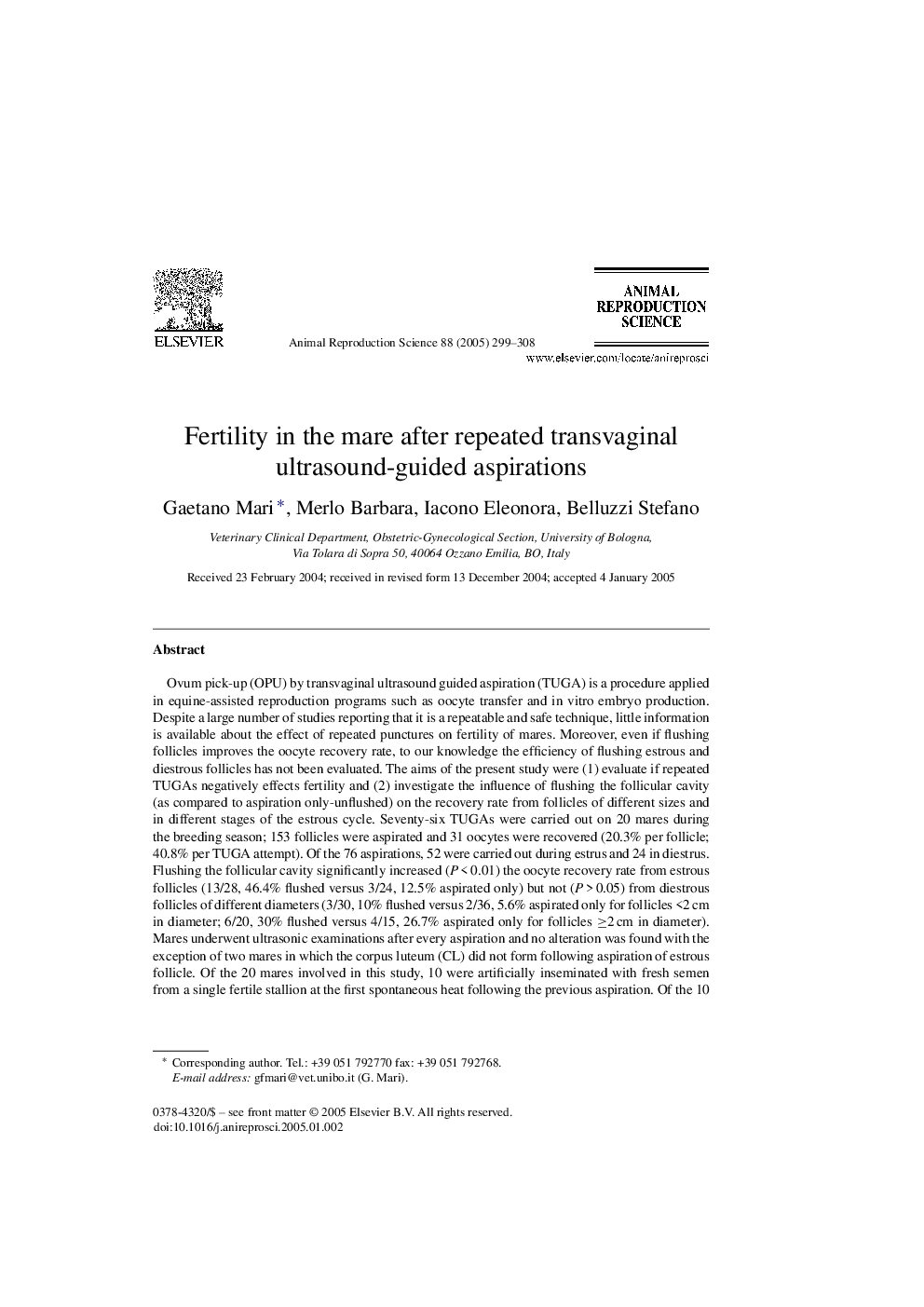| کد مقاله | کد نشریه | سال انتشار | مقاله انگلیسی | نسخه تمام متن |
|---|---|---|---|---|
| 9900274 | 1544837 | 2005 | 10 صفحه PDF | دانلود رایگان |
عنوان انگلیسی مقاله ISI
Fertility in the mare after repeated transvaginal ultrasound-guided aspirations
دانلود مقاله + سفارش ترجمه
دانلود مقاله ISI انگلیسی
رایگان برای ایرانیان
کلمات کلیدی
موضوعات مرتبط
علوم زیستی و بیوفناوری
علوم کشاورزی و بیولوژیک
علوم دامی و جانورشناسی
پیش نمایش صفحه اول مقاله

چکیده انگلیسی
Ovum pick-up (OPU) by transvaginal ultrasound guided aspiration (TUGA) is a procedure applied in equine-assisted reproduction programs such as oocyte transfer and in vitro embryo production. Despite a large number of studies reporting that it is a repeatable and safe technique, little information is available about the effect of repeated punctures on fertility of mares. Moreover, even if flushing follicles improves the oocyte recovery rate, to our knowledge the efficiency of flushing estrous and diestrous follicles has not been evaluated. The aims of the present study were (1) evaluate if repeated TUGAs negatively effects fertility and (2) investigate the influence of flushing the follicular cavity (as compared to aspiration only-unflushed) on the recovery rate from follicles of different sizes and in different stages of the estrous cycle. Seventy-six TUGAs were carried out on 20 mares during the breeding season; 153 follicles were aspirated and 31 oocytes were recovered (20.3% per follicle; 40.8% per TUGA attempt). Of the 76 aspirations, 52 were carried out during estrus and 24 in diestrus. Flushing the follicular cavity significantly increased (P < 0.01) the oocyte recovery rate from estrous follicles (13/28, 46.4% flushed versus 3/24, 12.5% aspirated only) but not (P > 0.05) from diestrous follicles of different diameters (3/30, 10% flushed versus 2/36, 5.6% aspirated only for follicles <2 cm in diameter; 6/20, 30% flushed versus 4/15, 26.7% aspirated only for follicles â¥2 cm in diameter). Mares underwent ultrasonic examinations after every aspiration and no alteration was found with the exception of two mares in which the corpus luteum (CL) did not form following aspiration of estrous follicle. Of the 20 mares involved in this study, 10 were artificially inseminated with fresh semen from a single fertile stallion at the first spontaneous heat following the previous aspiration. Of the 10 inseminated mares, 7 were found to be pregnant 16, 30 and 50 days after artificial insemination (AI), indicating that repeated TUGAs did not adversely affect fertility.
ناشر
Database: Elsevier - ScienceDirect (ساینس دایرکت)
Journal: Animal Reproduction Science - Volume 88, Issues 3â4, September 2005, Pages 299-308
Journal: Animal Reproduction Science - Volume 88, Issues 3â4, September 2005, Pages 299-308
نویسندگان
Gaetano Mari, Merlo Barbara, Iacono Eleonora, Belluzzi Stefano,